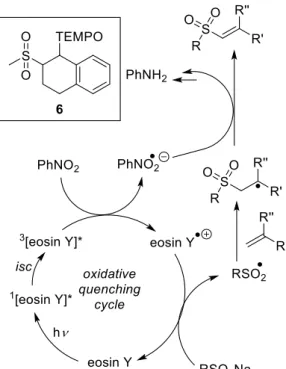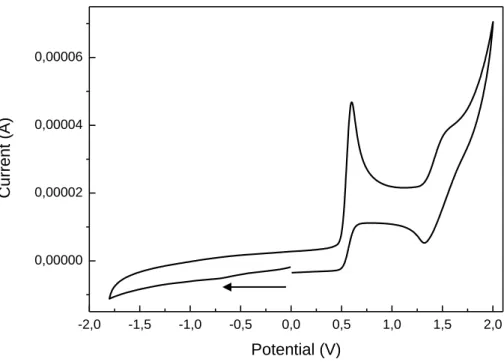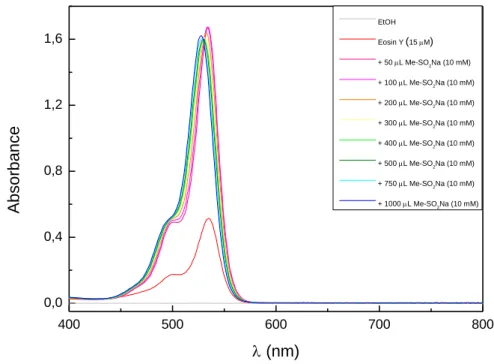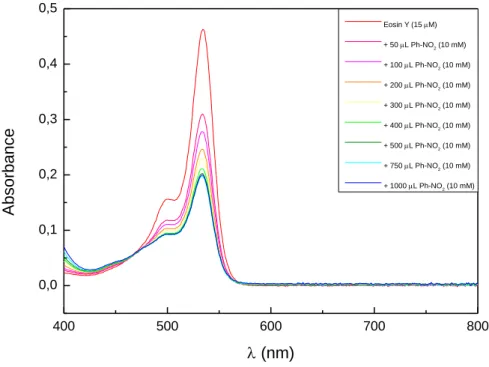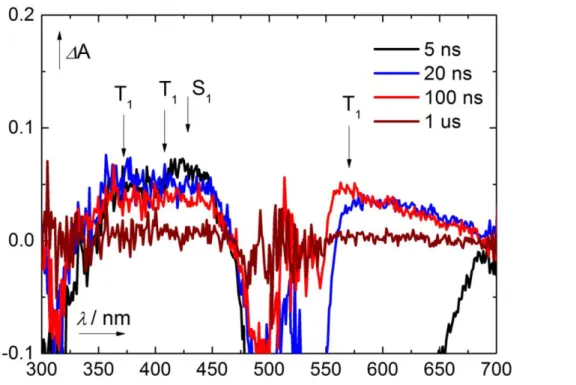Organic Photoredox Catalysis
Oxidation of Sulfur Containing Compounds and Reduction of Aryl Halides
Dissertation
Zur Erlangung des Doktorgrades der Naturwissenschaften (Dr. rer. nat.)
an der Fakultät für Chemie und Pharmazie der Universität Regensburg
vorgelegt von
Andreas Uwe Meyer
aus Straubing 2017
The experimental work was carried out between November 2014 and March 2017 at the University of Regensburg, Institute of Organic Chemistry under the supervision of Prof. Dr. Burkhard König.
Date of submission: 05.05.2017
Date of colloquium: 07.07.2017
Board of examiners:
Prof. Dr. David Díaz-Díaz (Chair)
Prof. Dr. Burkhard König (1st Referee)
Prof. Dr. Arno Pfitzner (2nd Referee)
Prof. Dr. Frank-Michael Matysik (Examiner)
To my family
&
Julia
Table of Contents
1. Photocatalytic Anion Oxidation and Applications in Organic Synthesis ... 1
1.1 Introduction ... 2
1.2 Nitrate Radicals NO3● from Nitrate Anions ... 3
1.3 Photocatalytic Generation of SCN● ... 7
1.4 Photooxidation of N3– to N3● ... 8
1.5 Oxidation of Sulfinates ... 9
1.6 Oxidative Photochlorination ... 13
1.7 Conclusion and Outlook ... 16
1.8 References ... 17
2. Eosin Y (EY) Photoredox-Catalyzed Sulfonylation of Alkenes: Scope and Mechanism ... 22
2.1 Introduction ... 23
2.2 Results and Discussion ... 24
2.2.1 Synthesis ... 24
2.2.2 Mechanistic Investigations ... 28
2.3 Conclusion ... 32
2.4 Experimental Part ... 33
2.4.1 General Information ... 33
2.4.2 General Procedures ... 36
2.4.2.1 General procedure for the preparation of sodium sulfinates ... 36
2.4.2.2 General procedure for the preparation of lithium sulfinates ... 36
2.4.2.3 General procedure for the photocatalytic vinyl sulfone synthesis ... 36
2.4.2.4 General procedure for the synthesis of cyclic sulfones ... 50
2.4.3 Hydrogen Evolution ... 60
2.4.4 Tempo Trapping of Radical Reaction Intermediates ... 61
2.4.5 Determination of Byproducts ... 62
2.4.6 Cyclic Voltammetry Measurements ... 63
2.4.7 Spectroscopic Investigation of the Mechanism ... 67
2.4.7.1 Steady state spectroscopy ... 67
2.4.7.2 Transient spectroscopy ... 69
2.4.7.3 Quantum yield determination ... 74
2.4.8 Sulfinate Oxidation Using tert-Butyl hydroperoxide ... 75
2.4.9 1H-, 13C- and 19F-spectra of Selected Compounds ... 80
2.5 References ... 102
3. Photocatalytic Oxidation of Sulfinates to Vinyl Sulfones with Cyanamide- Functionalised Carbon Nitride ... 107
3.1 Introduction ... 108
3.2 Results and Discussion ... 110
3.2.1 Synthesis ... 110
3.2.2 Mechanistic Investigations ... 115
3.3 Conclusion ... 118
3.4 Experimental Part ... 119
3.4.1 General Information ... 119
3.4.2 General Procedure for the Photocatalytic Vinyl Sulfone Synthesis ... 119
3.4.3 Additional Characterisations ... 123
3.4.4 1H-, 13C- and 19F-spectra of Selected Compounds ... 125
3.5 References ... 130
4. Metal-Free C–H Sulfonamidation of Pyrroles by Visible Light Photoredox Catalysis ... 133
4.1 Introduction ... 134
4.2 Results and Discussion ... 136
4.3 Conclusion ... 141
4.4 Experimental Part ... 142
4.4.1 General Information ... 142
4.4.2 General Procedures ... 142
4.4.2.1 General procedure for the preparation of sulfonamides ... 142
4.4.2.2 General reaction conditions for the photocatalytic sulfonamidation .. 142
4.4.3 Cyclic Voltammetry Measurements ... 158
4.4.4 1H- and 13C-spectra of Selected Compounds ... 159
4.5 References ... 167
5. Visible-Light-Accelerated C–H Sulfinylation of Heteroarenes ... 170
5.1 Introduction ... 171
5.2 Results and Discussion ... 173
5.2.1 Synthesis ... 173
5.2.2 Mechanistic Investigations ... 176
5.3 Conclusion ... 178
5.4 Experimental Part ... 179
5.4.1 General Information ... 179
5.4.2 General Procedures ... 179
5.4.2.1 General procedure for the preparation of sulfinamides ... 179
5.4.2.2 General reaction conditions for the Friedel-Crafts-type sulfinylation . 181 5.4.3 Cyclic Voltammetry Measurements ... 201
5.4.4 Investigation of the Mechanism ... 202
5.4.4.1 Proposed mechanism for the Friedel-Crafts-type sulfinylation ... 202
5.4.4.2 Steady state spectroscopy ... 204
5.4.4.3 Competition experiments ... 207
5.4.5 Comparison of the Potential Intermediate with the Vilsmeier Reagent .... 209
5.4.6 1H- and 13C-spectra of Selected Compounds ... 211
5.5 References ... 224
6. Metal-Free Perfluoroarylation by Visible Light Photoredox Catalysis ... 228
6.1 Introduction ... 229
6.2 Results and Discussion ... 231
6.2.1 Synthesis ... 231
6.2.2 Mechanistic Investigations ... 235
6.3 Conclusion ... 244
6.4 Experimental Part ... 245
6.4.1 General Information ... 245
6.4.2 General Procedures ... 245
6.4.2.1 General procedure for the preparation of polyfluorinated biaryls ... 245
6.4.2.2 Functionalization of brucine ... 258
6.4.3 Tempo Trapping of Radical Reaction Intermediates ... 260
6.4.4 Cyclic Voltammetry Measurements ... 261
6.4.5 Spectroscopic Investigation of the Mechanism ... 262
6.4.5.1 Steady state spectroscopy ... 262
6.4.5.2 Transient spectroscopy ... 264
6.4.5.3 Quantum yield determination ... 265
6.4.5.4 Determination of length of radical chain propagation ... 266
6.4.5.5 Preparation of bis(triethylammonium) eosin salt ... 267
6.4.6 1H-, 13C- and 19F-spectra of Selected Compounds ... 268
6.5 References ... 283
7. Metal Ion Coupled Consecutive Photoinduced Electron Transfer Generates Strong Reduction Potentials from Visible Light ... 288
7.1 Introduction ... 289
7.2 Results and Discussion ... 291
7.2.1 Synthesis ... 291
7.2.2 Mechanistic Investigations ... 294
7.3 Conclusion ... 299
7.4 Experimental Part ... 300
7.4.1 General Information ... 300
7.4.2 General Procedures ... 300
7.4.2.1 General procedure for the reduction of aryl halides ... 300
7.4.2.2 General procedure for the photocatalytic C–C bond formation ... 300
7.4.2.3 General procedure for the photocatalytic C–P bond formation ... 301
7.4.3 Deuteration of Aryl Radicals ... 302
7.4.4 NMR Study ... 303
7.4.5 Spectroscopic Investigation of the Mechanism ... 305
7.4.6 Electron Paramagnetic Resonance ... 312
7.4.7 Cyclic Voltammetry Measurements ... 314
7.5 References ... 315
8. Summary ... 319
9. Zusammenfassung ... 321
10. Abbreviations ... 323
11. Curriculum Vitae ... 327
12. Danksagung ... 330
1
1. Photocatalytic Anion Oxidation and Applications in Organic Synthesis
Ions and radicals of the same kind differ by one electron only. The oxidation of many stable inorganic anions yield their corresponding highly reactive radicals and visible light excitable photocatalysts can provide the required oxidation potential for this transformation. Air oxygen serves as the terminal oxidant or cheap sacrificial oxidants are used providing a very practical approach for generating reactive inorganic radicals for organic synthesis. We discuss in this perspective several recently reported examples: Nitrate radicals are obtained by one-electron photooxidation of nitrate anions and are very reactive towards organic molecules. The photooxidation of sulfinate salts yield the much more stable sulfone radicals, which smoothly add to double bonds. A two-electron oxidation of chloride anions to electrophilic chlorine species reacting with arenes in aromatic substitutions extends the method beyond radical reactions. The chloride anion oxidation proceeds via photocatalytically generated peracidic acid as oxidation reagent. Although the number of reported examples of photocatalytically generated inorganic radical intermediates for organic synthesis is still small, the future extension of the concept to other inorganic ions as radical precursors is a clear perspective.
This chapter has been published in:
T. Hering, A. U. Meyer, B. König, J. Org. Chem. 2016, 81, 6927-6936. (Review Article) – Reproduced with permission from J. Org. Chem. 2016, 81, 6927-6936. Copyright © 2016, American Chemical Society.[i]
Author contribution:
AUM wrote chapter 1.5. TH wrote chapters 1.2-1.4 and 1.6. BK wrote chapters 1.1 and 1.7 and is corresponding author.
2
1.1 Introduction
A one-electron oxidation converts anions into radicals connecting ionic chemistry and radical chemistry. With many inorganic anions readily available the simple transformation provides access to heteroatom-centered radicals with often high reactivity. However, the use of chemical one-electron oxidizing reagents may not be economical and creates by-products, while electrochemical oxidation requires special apparatus and involves a surface reaction at the electrodes. Therefore, visible light induced homogeneous photooxidations have developed into a useful alternative generating reactive intermediates in a catalytic fashion using light as a traceless reagent.
We focus in this perspective on the visible light mediated photooxidation of inorganic anions and exclude carbanions (Figure 1-1). Inorganic anions vary significant in their basicity and require therefore different potentials for their oxidation. We start our survey with the nitrate anion, which needs a strongly photooxidizing acridinium dye for the transformation into the nitrate radical.
Pseudohalides, like azide or thiocyanate anions, and sulfinates are oxidized at lower potentials.
The chemical reactivity of the obtained radicals towards organic molecules depends on the stability of the radical and can vary drastically. The nitrate radical is an example for high reactivity, while the sulfur-centered sulfone radicals obtained from sulfinate oxidation react rather selective.
In the last part of this perspective we extend the oxidation to a two-electron process and discuss the generation of electrophilic chlorine “Cl+” from chloride “Cl-“ anions by a photochemical oxidation using in situ generated peracetic acid as redox mediator.
The discussed examples of photocatalytic anion oxidation and use of the resulting highly reactive radicals in bond formation or oxidation reactions illustrate the potential of the concept. However, a much larger scope may be envisaged and established over the next years considering the large variety of inorganic anions that may be suitable starting materials.
Figure 1-1. Photocatalytic oxidation of inorganic anions into radicals and their use in organic synthesis.
3
1.2 Nitrate Radicals NO3● from Nitrate Anions
The nitrate radical NO3• is a unique oxygen-centered radical with a high oxidative power (+2.00 V vs SCE in MeCN) and a versatile reactivity.[1] It can undergo electron transfer (ET), add to systems or abstract hydrogen atoms (HAT). Moreover, NO3• is the most important free radical oxidant in the nighttime troposphere, where it is generated from the atmospheric pollutants nitrogen dioxide and ozone and reacts with volatile organic compounds emitted into the atmosphere.[1a, 2] These properties make it an interesting reagent for organic synthesis. However, while transformations in the atmosphere have been widely explored, surprisingly few work has been done to apply NO3• to synthetic chemistry.[3] This is mainly caused by its difficult accessibility. Conventional preparation requires toxic gases or UV irradiation of (NH4)2Ce(NO3)6
(CAN), which limits its potential application. The ideal preparation of NO3• would be by one electron oxidation of nitrate anions, which has been reported electrochemically. However, high electrode potentials are necessary and lead to unselective background reactions.[3a]
Using visible light photoredox catalysis to form NO3• by catalytic oxidation of readily available NO3- overcomes some of these drawbacks and generates the reactive radical under mild conditions in preparative scale. As depicted in Figure 1-2 a purely organic dye 9-mesityl-10- methylacridinium perchlorate (Acr+-Mes)[4] can be used as the photocatalyst and oxygen as the terminal oxidant.[5]
Figure 1-2. Photoredox catalyzed oxidation of nitrate ions to NO3•.
Spectroscopic studies on the mechanism of NO3• generation revealed that the reaction proceeds by direct oxidation of nitrate ions from the excited singlet state of the photocatalyst with subsequent re-oxidation of the reduced catalyst by aerial oxygen. To prove that nitrate ions act as electron donors to the excited state of Acr+-Mes a 5 µM solution of Acr+-Mes in MeCN was continuously irradiated with 455 nm light under anaerobic conditions. The differential absorption spectrum shows the appearance of the reduced catalyst Acr•-Mes with a maximum at 520 nm[4, 6]
after irradiation for 120 s and 240 s. The signal of Acr•-Mes vanished completely after aeration of the solution as Acr•-Mes is re-oxidized to the ground state catalyst Acr+-Mes by oxygen. This is in accordance with the mechanism proposed in Figure 1-2.
4
To further investigate how NO3• is formed by photoredox catalysis laser flash photolysis (LFP) and fluorescence quenching was performed to identify the excited state, which is responsible for the oxidation of nitrate ions. The long-lived triplet state with a microsecond lifetime is generally discussed as the reactive state in the majority of the reported oxidative reactions,[7] but judging by the redox potentials (+1.88 V vs SCE for CTT [7a] or +1.45 V vs SCE for LET [7b]) it does not have the oxidative capacity to oxidize NO3–. Indeed, LFP measurements showed no interaction between the long-lived triplet state and NO3-, whereas fluorescence measurements showed a quenching of the emission. This clearly indicates a reaction from the singlet state as the triplet states of Acr+-Mes do not emit.[6]
After investigating the mechanism of the photocatalytic generation of NO3•, the radical was applied for the oxidation of an aromatic alkyne 1 (Scheme 1-1a). The oxidation reaction proceeds by addition of NO3• to the alkyne yielding either benzil (2) or acetophenone (3) by loss of CO and has been described with previous methods for the generation of NO3.[3d] This is an example where NO3 serves as an oxygen transfer reagent. Using the photocatalytic method with 5 mol%
of Acr+-Mes, 0.25 mmol of diphenyl acetylene 1 and 2 eq. of LiNO3 after 2 h of blue light irradiation (max= 455 nm) comparable yields and product ratios were obtained as with the previously described methods.
5
Scheme 1-1. Oxidation of -systems by addition of NO3•: a) oxygenation of diphenylacetylene. b) Self-terminating radical cascade reaction.
The developed photocatalytic NO3• formation was further applied to the synthesis of tetra- substituted tetrahydrofurans (Scheme 1-1b). A reaction is initiated like in the previous example by NO3• addition to the triple bond of alkyne 4 and then proceeds via a self-terminating radical cascade.[3b, 3c] The cyclized product 5 could be obtained in 37% (67% based on conversion), with 45% recovered starting material. The low conversion and the resulting low product yield can be rationalized by the observed bleaching of the photocatalyst presumably caused by oxidation of the methyl groups on the mesityl moiety of Acr+-Mes,[8] a known degradation pathway leading to the loss of catalytic activity.[9] Therefore the yields could be slightly increased by slow addition of Acr+-Mes via a syringe pump.
Besides the addition to systems, NO3• can also oxidize substrates by hydrogen atom abstraction.[8, 10] This was applied for the catalytic oxidation of non-activated alcohols (Scheme 1- 2). The reaction proceeds by initial HAT from the alcohol carbon by NO3• regenerating NO3–
(Scheme 1-2a)[11] that can be once more oxidized to generate another molecule of NO3•. In this reaction NO3• acts as a redox mediator enabling the oxidation, but is not consumed. Thus nitrate can be used in catalytic amounts. During the reaction an acidification of the solution is observed, but does not affect the reaction. The scope of the alcohol oxidation is depicted in Scheme 1-2.
Non-activated alcohols can be converted to the corresponding ketones in good selectivity, but
6
with moderate yields as degradation of the catalyst by NO3• leads to incomplete conversion.
Noteworthy, isomenthol can be converted to isomethone (9c) without a change in the configuration of the stereocenter.
Scheme 1-2. a) Mechanistic scheme of the alcohol oxidation by NO3•. b) Experimental conditions and results for the NO3• mediated oxidation of alcohols.
The use of photoredox catalysis for the oxidation of abundant nitrate ions provides a simple access to highly reactive nitrate radicals and requires only light, air and an organic dye. This method is a clear advancement to existing methods as it avoids the use of toxic compounds, or high electrochemical potentials and demonstrates how reactive radicals can be generated from their corresponding anion by photoredox catalysis.
7
1.3 Photocatalytic Generation of SCN●
This strategy has also been used to oxidize other rather unreactive inorganic anions transforming them into reactive radicals. In 2014 Li et al. reported the Rose Bengal catalyzed thiocyanation of indoles 10 using SCN-.[12] The reaction proceeds by reductive quenching of the excited state of Rose Bengal by SCN- giving SCN, which subsequently adds to an indole yielding the corresponding thiocyanated product 12. As in the case of NO3• molecular oxygen serves as the terminal oxidant. Using this procedure, they synthesized a variety of 3-thiocyanated indoles 12 with yields up to 98%. Later the groups of Hajra and Yadav used a similar eosin Y catalyzed process to achieve the thiocyanation and selenocyanation of imidazoheterocycles 13[13] and the synthesis of 5-aryl-2-imino-1,3-oxathiolanes 16 by addition of SCN to styrenes 15’.[14] All reactions are initiated by the formation of an SCN or SeCN from the corresponding anion and give access to valuable structures by a mild metal free catalysis (Scheme 1-3).
Scheme 1-3. SCN• addition to a) indoles b) imidazoles and to styrenes (bottom).
8
1.4 Photooxidation of N3– to N3●
Another interesting radical, which can be generated by oxidation from its corresponding anion is the azidyl radical N3. Organic azides are important precursors in the synthesis of complex molecules as they can be reduced to the amine or used in click reactions.[15] Griesbeck et al.
have reported the visible light photocatalytic generation of azidyl radicals from azides in the presence of oxygen using a variety of different sensitizers.[16] The xanthene dye Rhodamine B (Scheme 1-4) proved to be the most efficient sensitizer; however, the nanosized particles of the inorganic semiconductors CdS and TiO2[17] can also be applied as a photocatalyst in this transformation. The addition of N3 to olefins 17 with subsequent trapping of the resulting carbon radical by oxygen leads to 1,2-azidohydroperoxides 19, which can be later transformed into 1,2- azidoalcohols or 1,2-aminoalcohols. The scope of the reaction includes cycloalkenes, allyl alcohols and Michael acceptors and is exemplarily shown in Scheme 1-4.
Scheme 1-4. Azidoperoxidation of alkenes with selected examples.
9
1.5 Oxidation of Sulfinates
Sodium sulfinates are versatile reagents in organic and medicinal chemistry. They are bench stable, easy to handle, moisture-insensitive and readily available.[18] Compared to sulfonyl chlorides and sulfinic acids, sodium sulfinates are more stable and therefore used preferentially for organic transformations.[18] Sodium sulfinates are prepared from the corresponding sulfonyl chloride by adding sodium sulfite and sodium bicarbonate.[19] Alternatively, sodium sulfinates are obtained by a four step synthesis reported by Baran et al. starting from carboxylic acids.[20] Zinc sulfinates are known as well, but found just few applications.[21] Sulfinates exhibit a dual reactivity as they can react sulfonylative or desulfitative, which was recently summarized by Hamze et al.[18]
Baran et al. performed the C–H functionalization of heteroarenes by oxidizing the sulfinate with tert-butylhydroperoxide, which reacts under loss of SO2 to valuable products.[20, 22] Nicewicz et al.
reported a photoredox-catalyzed desulfitative hydrotrifluoromethylation of styrenes by oxidation of sodium trifluoromethanesulfinate (Langlois reagent).[23] The Langlois reagent reacts always under loss of SO2.[24] By preserving the SO2 moiety, vinyl sulfones can be prepared, which are used in organic transformations.[25] They are also of biological importance,[26] for example as inhibitors for different enzymes.[27] Vinyl sulfones can be prepared by transition metal catalyzed reactions of sulfinates with alkenes or alkynes,[28] or by decarboxylative sulfonylation reactions with sodium sulfinates.[29] In 2015, our group reported a mild, photoredox-catalyzed synthesis of vinyl sulfones from alkenes and sodium aryl sulfinates.[30] Another approach using visible light photooxidation for the synthesis of coumarin derivatives from comparable less stable sulfinic acids with phenyl propiolates was published in the same year.[31] Both methods are limited to aryl vinyl sulfones, as most reported methods. Exceptions are copper[32] or ammonium iodide catalyzed syntheses of vinyl methyl sulfones from DMSO with alkenes or alkynes.[33] To overcome the substrate scope limitation, our group recently extended the original method to sodium alkyl sulfinates.[34] Our eosin Y photoredox-catalyzed sulfonylation protocol enables the metal-free synthesis of alkyl- and aryl vinyl sulfones from sodium and lithium sulfinates.[30, 34] The reaction tolerates a wide range of functional groups, has a broad scope with respect to both alkyl- and (hetero)aryl sulfinates and activated alkenes, and the mechanism was studied in detail by transient spectroscopy.
The conditions were first optimized for [Ru(bpy)3]Cl2. The yield strongly depends on the solvent and increases in protic solvents. Ethanol was selected as solvent of choice and only for styrene derivatives a mixture of DMF and water was used, because traces of a by-product were formed with ethanol.[30, 34] The reaction conditions were then optimized for the organic dye eosin Y as photocatalysts.[35] The yield increased compared to [Ru(bpy)3]Cl2. Nitrobenzene is the best oxidant for this reaction, but air oxygen is working as well with slightly lower yields. The reaction is performed under air and the oxygen in the air atmosphere acts as secondary terminal oxidant.
Reactions under nitrogen only in the presence of nitrobenzene showed slightly decreased yields.
In the absence of any terminal oxidant it is possible to evolve hydrogen as the only by-product
10
using [Co(dmgH)2(py)Cl] as hydrogen-evolving co-catalyst.[36] The yield of the vinyl sulfone formation under these conditions is comparable to the reaction in oxygen atmosphere.
The scope of substrates (Scheme 1-5) was explored using the general reaction conditions (3 eq.
of sulfinate 20, 1 eq. of alkene 15, 10 mol% eosin Y and 1 eq. of nitrobenzene as oxidant). The low reactivity of the sulfone radical makes the method selective for activated alkenes. In total 37 examples with yields up to 99% were isolated. Aryl, heteroaryl and alkyl sulfinates were reacted with dihydronaphthalenes, styrenes and dihydroquinolines. The preservation of the SO2 moiety was confirmed by X-ray single crystal analysis for the compounds 21a, 21p, 21q, 21r, 21y, 21ac and 21ad. The mild conditions tolerate electron withdrawing and electron donating groups as well as bromide and chloride substituents, which allow further synthetic modifications. Also the irreversible receptor antagonist N-ethoxycarbonyl-2-ethoxy-1,2-dihydroquinoline (EEDQ)[37] and the alkaloid piperine were used as substrates giving products 21ah-ak.
Scheme 1-5. Scope of vinyl sulfones (isolated yields).[30, 34]
By merging two sequential photocatalytic reactions, complex cyclic sulfones could be synthesized (Scheme 1-6). The reaction of unsaturated sulfinates with styrene derivatives led to precursors for photocatalyzed intramolecular [2+2] cycloadditions 21al-ap. The method by Cibulka et al.[38] led
11
to a diastereomeric mixture of complex sulfones 22a-e with five-membered heterocycles 23 as by-product.
Scheme 1-6. Synthesis of complex cyclic sulfones 22 and 23 (isolated yields).[34]
The proposed mechanism for the eosin Y catalyzed sulfonylation of alkenes is shown in Scheme 1-7. Eosin Y is excited by green light irradiation. Oxidative quenching of the triplet state by nitrobenzene produces the radical cation of eosin Y, which was confirmed by transient spectroscopy.[34, 39] Oxidation of the sulfinate salt by the eosin Y radical cation yields the sulfone radical, which reacts with the alkene, forming radical intermediate 21•. After H-atom abstraction by the nitrobenzene radical anion, product 21 is obtained. The radical intermediate 21• was confirmed by trapping with the persistent radical TEMPO yielding compounds 24 and 24’.[30, 34]
The quantum yield was determined to be Φ = 1.3 + 0.4 % reflecting the comparable long reaction times.
12
Scheme 1-7. Confirmed mechanism for the eosin Y catalyzed sulfonylation of alkenes.[30, 34]
13
1.6 Oxidative Photochlorination
The examples in the previous sections have demonstrated how photoredox catalysis can be used to generate radicals from the corresponding inorganic anions by one electron oxidation. It is also possible to go a step further and generate electrophilic species “X+”, namely “Cl+”, by oxidation from the corresponding anion Cl-. However, this oxidation is more challenging and cannot be realized by two subsequent one electron oxidation steps X- X X+ since the resulting radicals X are generally too reactive to live long enough for a second oxidation to occur. Moreover, these electrophilic species generally do not exist in their free form. Although there is no free “Cl+” in solution, several reagents provide an electrophilic chlorine atom such as tBuOCl, NCS, HOCl, Palau’Chlor[40] or Cl2/AlCl3. These reagents are commonly used for electrophilic chlorination.
They are synthesized using toxic chlorine gas. Nature is able to perform electrophilic chlorinations starting from chloride anions using enzymatically catalyzed oxidative chlorination.[41] Flavin adenine dinucleotide (FAD)-dependent halogenases efficiently yield aryl halides from halide ions and arenes using O2 as the oxidant, while other families of halogenases (haloperoxidases) rely on H2O2 as the oxidant.[41] This oxidative chlorination strategy is very appealing since it produces only water as the by-product and uses abundant, non-toxic Cl- as the chlorine source, thus a variety of chemical oxidative halogenations have been developed.[42] Even though great progress has been made in the area of oxidative bromination, only few examples are known for chemical oxidative chlorination suffering from drastic conditions and low selectivity [42-43] or require strong or metal based stoichiometric oxidants.[44]
Therefore we have developed a photocatalytic biomimetic system derived from FAD-dependent halogenases.[45] A simplified mechanism of the enzymatic generation of the electrophilic chlorine species HOCl and the analogy to the photocatalytic system is illustrated in Scheme 1-8. In the photocatalytic process the biomolecules FAD and NADH2 were replaced by the cheap organic dye riboflavin tetraacetate (RFT) and a benzylic alcohol as the reducing agent.[46] The proposed mechanism proceeds by reduction of RFT to RFTH2 or in the enzyme from FAD to FADH2, respectively. Both reduced species react quickly with oxygen to form the peroxide species RFT- OOH or FAD-OOH. Subsequent attack of Cl- should lead to the formation of HOCl.
14
Scheme 1-8. Simplified mechanism of the oxidation of Cl- by FAD-dependent halogenases (top) and the analogy to the proposed photocatalyzed biomimetic system (bottom).
However, the activation by the enzyme is somehow more complex and involves amino acid side chains and ion channels[41, 47] thus the photocatalytic system requires a mediator, which takes the role of the enzyme binding pocket and overcomes the barrier for the reaction of chloride and the peroxide. A chemical compound, which is able to oxidize Cl- is peracetic acid,[45] which if isolated is highly explosive, but it is safely obtained in an equilibrium of acetic acid and H2O2.[48] The flavin peroxide RFT-OOH formed in the reaction is reported to quickly release H2O2 and thus the addition of acetic acid enabled the oxidative chlorination of anisole (25a) by forming peracetic acid in situ (Scheme 1-9).
Scheme 1-9. RFT catalyzed visible light mediated oxidative chlorination by in situ generation of peracetic acid (pMBA= para-methoxy benzyl alcohol).
Compared to an enzyme binding pocket the peracid mediation presents a more general way of activation and allows a broader substrate scope. As depicted in Scheme 1-10 several electron rich arenes can be chlorinated in excellent to moderate yields and acetophenone derivatives can be monochlorinated in the -position. The addition of H2O2 directly gives considerably lower
15
yields compared to the formation by the photocatalytic process as the slow generation of H2O2
reduces unselective side reactions and multiple chlorination. The reported visible light photocatalysis allows the oxidation of Cl- to an electrophilic chlorine using a strategy inspired by an enzymatic system.
Scheme 1-10. Scope of the flavin catalyzed oxidative chlorination and comparison to the direct addition of H2O2 (yields based on conversion).
16
1.7 Conclusion and Outlook
Visible light, air oxygen and a suitable photocatalyst mediating the one-electron oxidation are in many cases sufficient to convert a stable inorganic anion into a highly reactive heteroatom- centered radical that can be used in organic transformations. The simple conditions favor applications in synthesis, as expensive and sensitive stoichiometric oxidants or electrochemical set ups are avoided. The inorganic radicals undergo depending on their intrinsic reactivity C–H abstraction or addition to double bonds or arenes. A much broader scope of the inorganic anions as radical precursors can be imagined than described so far, but many may react only via rather unselective hydrogen atom abstraction due to their high reactivity. There are several challenges ahead extending the method: Many non-basic anions are currently outside the reachable oxidation potential of visible light photocatalysts, which is at approximately +2.1 V vs SCE. The use of more than one visible light photon for an oxidation process may well extend this range.
Consecutive photoinduced electron transfer (conPET)[49] was successfully applied reaching reduction potentials of up to -2.4 V vs SCE by accumulating the energy of two visible light photons and a similar process may be used in photooxidations. The high reactivity of photo- generated inorganic radicals leads to unspecific organic transformations. Synergistic catalysis using e.g. radical stabilizing metal complexes may allow more selective reactions. The use of flow chemistry may also be considered as many previous examples have shown the advantage for syntheses involving highly reactive intermediates. The photochemical generation of the radical and its subsequent reaction with an organic substrate can be combined into a single flow process, which also facilitates reactions at larger scale.
Most photooxidations of anions are one-electron processes giving radicals. Our example of converting chloride anions into electrophilic chlorine species demonstrates that an extension of the concept beyond radical chemistry is possible, although the oxidation in this case proceeds via photo-generated peracetic acid. Related photocatalytic oxidative generations of electrophilic species may be envisaged and wait for their future discovery.
17
1.8 References
[1] a) R. P. Wayne, I. Barnes, P. Biggs, J. P. Burrows, C. E. Canosa-Mas, J. Hjorth, G. Le Bras, G. K. Moortgat, D. Perner, G. Poulet, G. Restelli, H. Sidebottom, Atmos. Environ., Part A 1991, 25, 1-203; b) O. Ito, S. Akiho, M. Iino, J. Phys. Chem. 1989, 93, 4079-4083.
[2] a) M. P. Pérez-Casany, I. Nebot-Gil, J. Sánchez-Marín, F. Tomás-Vert, E. Martínez-Ataz, B. Cabañas-Galán, A. Aranda-Rubio, J. Org. Chem. 1998, 63, 6978-6983; b) H. Gong, A.
Matsunaga, P. J. Ziemann, J. Phys. Chem. A 2005, 109, 4312-4324; c) D. Rousse, C.
George, Phys. Chem. Chem. Phys. 2004, 6, 3408-3414.
[3] a) T. Shono, M. Chuankamnerdkarn, H. Maekawa, M. Ishifune, S. Kashimura, Synthesis 1994, 1994, 895-897; b) U. Wille, L. Lietzau, Tetrahedron 1999, 55, 11465-11474; c) U.
Wille, L. Lietzau, Tetrahedron 1999, 55, 10119-10134; d) U. Wille, J. Andropof, Aust. J.
Chem. 2007, 60, 420-428; e) U. Wille, J. Am. Chem. Soc. 2001, 124, 14-15.
[4] S. Fukuzumi, H. Kotani, K. Ohkubo, S. Ogo, N. V. Tkachenko, H. Lemmetyinen, J. Am.
Chem. Soc. 2004, 126, 1600-1601.
[5] T. Hering, T. Slanina, A. Hancock, U. Wille, B. König, Chem. Commun. 2015, 51, 6568- 6571.
[6] N. A. Romero, D. A. Nicewicz, J. Am. Chem. Soc. 2014, 136, 17024-17035.
[7] a) S. Fukuzumi, K. Ohkubo, T. Suenobu, Acc. Chem. Res. 2014, 47, 1455-1464; b) A. C.
Benniston, A. Harriman, P. Li, J. P. Rostron, H. J. van Ramesdonk, M. M. Groeneveld, H.
Zhang, J. W. Verhoeven, J. Am. Chem. Soc. 2005, 127, 16054-16064.
[8] E. Baciocchi, T. D. Giacco, S. M. Murgia, G. V. Sebastiani, J. Chem. Soc., Chem.
Commun. 1987, 1246-1248.
[9] A. C. Benniston, K. J. Elliott, R. W. Harrington, W. Clegg, Eur. J. Org. Chem. 2009, 2009, 253-258.
[10] a) Andrey A. Fokin, Sergey A. Peleshanko, Pavel A. Gunchenko, Dmitriy V. Gusev, Peter R. Schreiner, Eur. J. Org. Chem. 2000, 2000, 3357-3362; b) M. Mella, M. Freccero, T. Soldi, E. Fasani, A. Albini, J. Org. Chem. 1996, 61, 1413-1422.
[11] a) S. Langer, E. Ljungstrom, J. Chem. Soc., Faraday Trans. 1995, 91, 405-410; b) D.
Kyriacou, Modern Electroorganic Chemistry, Springer-Verlag, Berlin, Heidelberg, 1994.
[12] W. Fan, Q. Yang, F. Xu, P. Li, J. Org. Chem. 2014, 79, 10588-10592.
[13] S. Mitra, M. Ghosh, S. Mishra, A. Hajra, J. Org. Chem. 2015, 80, 8275-8281.
[14] A. K. Yadav, L. D. S. Yadav, Green Chem. 2015, 17, 3515-3520.
[15] a) P. Thirumurugan, D. Matosiuk, K. Jozwiak, Chem. Rev. 2013, 113, 4905-4979; b) W.
H. Binder, C. Kluger, Curr. Org. Chem. 2006, 10, 1791-1815.
[16] a) A. Griesbeck, J. Steinwascher, M. Reckenthäler, J. Uhlig, Res. Chem. Intermed. 2013, 39, 33-42; b) A. G. Griesbeck, J. Lex, K. M. Saygin, J. Steinwascher, Chem. Commun.
2000, 2205-2206.
[17] A. G. Griesbeck, M. Reckenthäler, J. Uhlig, Photochem. Photobiol. Sci. 2010, 9, 775-778.
18
[18] J. Aziz, S. Messaoudi, M. Alami, A. Hamze, Org. Biomol. Chem. 2014, 12, 9743-9759.
[19] a) L. K. Liu, Y. Chi, K.-Y. Jen, J. Org. Chem. 1980, 45, 406-410; b) J. Liu, X. Zhou, H.
Rao, F. Xiao, C.-J. Li, G.-J. Deng, Chem. Eur. J. 2011, 17, 7996-7999.
[20] R. Gianatassio, S. Kawamura, C. L. Eprile, K. Foo, J. Ge, A. C. Burns, M. R. Collins, P. S.
Baran, Angew. Chem. Int. Ed. 2014, 53, 9851-9855.
[21] a) Y. Fujiwara, J. A. Dixon, F. O’Hara, E. D. Funder, D. D. Dixon, R. A. Rodriguez, R. D.
Baxter, B. Herlé, N. Sach, M. R. Collins, Y. Ishihara, P. S. Baran, Nature 2012, 492, 95- 99; b) Y. Fujiwara, J. A. Dixon, R. A. Rodriguez, R. D. Baxter, D. D. Dixon, M. R. Collins, D. G. Blackmond, P. S. Baran, J. Am. Chem. Soc. 2012, 134, 1494-1497; c) J. Gui, Q.
Zhou, C.-M. Pan, Y. Yabe, A. C. Burns, M. R. Collins, M. A. Ornelas, Y. Ishihara, P. S.
Baran, J. Am. Chem. Soc. 2014, 136, 4853-4856.
[22] a) Y. Ji, T. Brueckl, R. D. Baxter, Y. Fujiwara, I. B. Seiple, S. Su, D. G. Blackmond, P. S.
Baran, PNAS 2011, 108, 14411-14415; b) Q. Zhou, J. Gui, C.-M. Pan, E. Albone, X.
Cheng, E. M. Suh, L. Grasso, Y. Ishihara, P. S. Baran, J. Am. Chem. Soc. 2013, 135, 12994-12997; c) Q. Zhou, A. Ruffoni, R. Gianatassio, Y. Fujiwara, E. Sella, D. Shabat, P.
S. Baran, Angew. Chem. Int. Ed. 2013, 52, 3949-3952.
[23] D. J. Wilger, N. J. Gesmundo, D. A. Nicewicz, Chem. Sci. 2013, 4, 3160-3165.
[24] a) Q. Lu, C. Liu, P. Peng, Z. Liu, L. Fu, J. Huang, A. Lei, Asian J. Org. Chem. 2014, 3, 273-276; b) Q. Lu, C. Liu, Z. Huang, Y. Ma, J. Zhang, A. Lei, Chem. Commun. 2014, 50, 14101-14104; c) C. Liu, Q. Lu, Z. Huang, J. Zhang, F. Liao, P. Peng, A. Lei, Org. Lett.
2015, 17, 6034-6037.
[25] a) F. Hof, A. Schütz, C. Fäh, S. Meyer, D. Bur, J. Liu, D. E. Goldberg, F. Diederich, Angew. Chem. Int. Ed. 2006, 45, 2138-2141; b) J.-N. Desrosiers, A. B. Charette, Angew.
Chem. Int. Ed. 2007, 46, 5955-5957; c) G. Pandey, K. N. Tiwari, V. G. Puranik, Org. Lett.
2008, 10, 3611-3614; d) D. Ravelli, S. Montanaro, M. Zema, M. Fagnoni, A. Albini, Adv.
Synth. Catal. 2011, 353, 3295-3300; e) A. Noble, D. W. C. MacMillan, J. Am. Chem. Soc.
2014, 136, 11602-11605.
[26] a) D. C. Meadows, T. Sanchez, N. Neamati, T. W. North, J. Gervay-Hague, Biorg. Med.
Chem. 2007, 15, 1127-1137; b) I. D. Kerr, J. H. Lee, C. J. Farady, R. Marion, M. Rickert, M. Sajid, K. C. Pandey, C. R. Caffrey, J. Legac, E. Hansell, J. H. McKerrow, C. S. Craik, P. J. Rosenthal, L. S. Brinen, J. Biol. Chem. 2009, 284, 25697-25703.
[27] a) J. T. Palmer, D. Rasnick, J. L. Klaus, D. Bromme, J. Med. Chem. 1995, 38, 3193-3196;
b) B. A. Frankel, M. Bentley, R. G. Kruger, D. G. McCafferty, J. Am. Chem. Soc. 2004, 126, 3404-3405; c) S. Liu, B. Zhou, H. Yang, Y. He, Z.-X. Jiang, S. Kumar, L. Wu, Z.-Y.
Zhang, J. Am. Chem. Soc. 2008, 130, 8251-8260.
[28] N. Taniguchi, Synlett 2011, 09, 1308-1312.
[29] a) Q. Jiang, B. Xu, J. Jia, A. Zhao, Y.-R. Zhao, Y.-Y. Li, N.-N. He, C.-C. Guo, J. Org.
Chem. 2014, 79, 7372-7379; b) Y. Xu, X. Tang, W. Hu, W. Wu, H. Jiang, Green Chem.
19
2014, 16, 3720-3723; c) G. Rong, J. Mao, H. Yan, Y. Zheng, G. Zhang, J. Org. Chem.
2015, 80, 7652-7657.
[30] A. U. Meyer, S. Jäger, D. P. Hari, B. König, Adv. Synth. Catal. 2015, 357, 2050-2054.
[31] W. Yang, S. Yang, P. Li, L. Wang, Chem. Commun. 2015, 51, 7520-7523.
[32] a) Y. Jiang, T.-P. Loh, Chem. Sci. 2014, 5, 4939-4943; b) J.-Y. Chen, X.-L. Chen, X. Li, L.-B. Qu, Q. Zhang, L.-K. Duan, Y.-Y. Xia, X. Chen, K. Sun, Z.-D. Liu, Y.-F. Zhao, Eur. J.
Org. Chem. 2015, 2, 314-319.
[33] X. Gao, X. Pan, J. Gao, H. Huang, G. Yuan, Y. Li, Chem. Commun. 2015, 51, 210-212.
[34] A. U. Meyer, K. Straková, T. Slanina, B. König, Chem. Eur. J. 2016, 22, 8694-8699.
[35] D. P. Hari, B. König, Chem. Commun. 2014, 50, 6688-6699.
[36] a) S. Troppmann, B. König, Chem. Eur. J. 2014, 20, 14570-14574; b) G. Zhang, C. Liu, H.
Yi, Q. Meng, C. Bian, H. Chen, J.-X. Jian, L.-Z. Wu, A. Lei, J. Am. Chem. Soc. 2015, 137, 9273-9280.
[37] A. D. Crocker, D. L. Cameron, Clin. Exp. Pharmacol. Physiol. 1989, 16, 545-548.
[38] V. Mojr, E. Svobodová, K. Straková, T. Neveselý, J. Chudoba, H. Dvořáková, R. Cibulka, Chem. Commun. 2015, 51, 12036-12039.
[39] A. U. Meyer, T. Slanina, C.-J. Yao, B. König, ACS Catal. 2016, 6, 369-375.
[40] R. A. Rodriguez, C.-M. Pan, Y. Yabe, Y. Kawamata, M. D. Eastgate, P. S. Baran, J. Am.
Chem. Soc. 2014, 136, 6908-6911.
[41] F. H. Vaillancourt, E. Yeh, D. A. Vosburg, S. Garneau-Tsodikova, C. T. Walsh, Chem.
Rev. 2006, 106, 3364-3378.
[42] A. Podgoršek, M. Zupan, J. Iskra, Angew. Chem. Int. Ed. 2009, 48, 8424-8450.
[43] a) A. O. Terent’ev, S. V. Khodykin, N. A. Troitskii, Y. N. Ogibin, G. I. Nikishin, Synthesis 2004, 2004, 2845-2848; b) R. Ben-Daniel, S. P. de Visser, S. Shaik, R. Neumann, J. Am.
Chem. Soc. 2003, 125, 12116-12117.
[44] a) L. Gu, T. Lu, M. Zhang, L. Tou, Y. Zhang, Adv. Synth. Catal. 2013, 355, 1077-1082; b) K.-D. Umland, C. Mayer, S. F. Kirsch, Synlett 2014, 25, 813-816; c) J.-Y. Wang, Q. Jiang, C.-C. Guo, Synth. Commun. 2014, 44, 3130-3138; d) Z. Cong, T. Kurahashi, H. Fujii, Angew. Chem. 2011, 123, 10109-10113; e) A. K. Vardhaman, P. Barman, S. Kumar, C.
V. Sastri, D. Kumar, S. P. de Visser, Chem. Commun. 2013, 49, 10926-10928; f) P. J.
Hansen, J. H. Espenson, Inorg. Chem. 1995, 34, 5839-5844.
[45] T. Hering, B. Mühldorf, R. Wolf, B. König, Angew. Chem. Int. Ed. 2016, 55, 5342-5345.
[46] a) U. Megerle, M. Wenninger, R.-J. Kutta, R. Lechner, B. König, B. Dick, E. Riedle, Phys.
Chem. Chem. Phys. 2011, 13, 8869-8880; b) R. Lechner, S. Kümmel, B. König, Photochem. Photobiol. Sci. 2010, 9, 1367-1377.
[47] E. Yeh, L. C. Blasiak, A. Koglin, C. L. Drennan, C. T. Walsh, Biochemistry 2007, 46, 1284-1292.
20
[48] a) H. Klenk, P. H. Götz, R. Siegmeier, W. Mayr, in Ullmann's Encyclopedia of Industrial Chemistry, Wiley-VCH Verlag GmbH & Co. KGaA, 2000; b) X. Zhao, T. Zhang, Y. Zhou, D. Liu, J. Mol. Catal. A: Chem. 2007, 271, 246-252.
[49] a) I. Ghosh, T. Ghosh, J. I. Bardagi, B. König, Science 2014, 346, 725-728; b) I. Ghosh, B. König, Angew. Chem. Int. Ed. 2016, 55, 7676-7679.
[i] The graphical abstract is reproduced in the style of the published graphical abstract by Dr. Michal Poznik.
21
22
2. Eosin Y (EY) Photoredox-Catalyzed Sulfonylation of Alkenes: Scope and Mechanism
Alkyl- and aryl vinyl sulfones were obtained by eosin Y mediated visible light photooxidation of sulfinate salts and the reaction of the resulting S-centered radicals with alkenes. Optimized reaction conditions, the sulfinate and alkene scope and X-ray structural analyses of several reaction products are provided. A detailed spectroscopic study explains the reaction mechanism, which proceeds via the eosin Y radical cation as key intermediate oxidizing the sulfinate salts.
This chapter has been published in:
A. U. Meyer, K. Straková, T. Slanina, B. König, Chem. Eur. J. 2016, 22, 8694-8699. – Reproduced with permission from John Wiley and Sons.
Author contribution:
AUM carried out the photoreactions in Table 2-1 and Scheme 2-2 (including growing of single crystals), the hydrogen evolution experiments, the TEMPO trapping experiment, the determination of byproducts, the chemical sulfinate oxidation, the steady state spectroscopy experiments and the quantum yield determination. AUM wrote the manuscript with contributions from TS. TS performed the transient spectroscopy experiments. KS carried out the reactions in Table 2-2 and synthesized compound 3v of Scheme 2-2. BK supervised the project and is corresponding author.
23
2.1 Introduction
Sulfinates are interesting reagents for organic transformations. Many stable alkyl- or aryl sulfinic acids or their sodium or zinc salts are known or readily available. They are activated for reaction by transition metals or oxidants. Baran et al. used sodium alkyl sulfinates widely for the facile C–
H functionalization of heterocycles with biological relevance. tert-Butyl hydroperoxide initiates the radical reaction, which provides valuable products under loss of SO2 (Scheme 2-1, a).[1]
Transition metal catalyzed reactions of alkenes or alkynes with sodium sulfinates,[2] and alkynes with sulfinic acids[3] yield vinyl sulfones[4] preserving the SO2 group. Other approaches to vinyl sulfones are the decarboxylative sulfonylation of cinnamic acids[5] or phenylpropiolic acids with sodium sulfinates,[6] and the electrochemical synthesis from olefins and sodium sulfinates.[7] In 2015, two visible light photooxidation protocols were described for the synthesis of coumarin derivatives from phenyl propiolates with aryl sulfinic acids,[8] and the synthesis of aryl vinyl sulfones from olefins and aryl sulfinates.[9] However, their scope is limited to aryl vinyl sulfones.[10]
Vinyl methyl sulfone preparation, so far, requires copper catalyzed reactions of alkynes[11] or alkenes[12] with DMSO, or the ammonium iodide-induced sulfonylation of olefins with DMSO.[13]
Here we report a visible light-mediated, metal-free synthesis of alkyl and heteroaryl vinyl sulfones from alkyl or heteroaryl sulfinates and alkenes using green light, the organic dye eosin Y as photocatalyst and nitrobenzene or air as the terminal oxidant (Scheme 2-1, b). Alternatively the oxidative coupling reaction can be combined with a hydrogen evolution reaction.
Scheme 2-1. Comparison of sulfinate oxidations with loss or preservation of SO2.
24
2.2 Results and Discussion
2.2.1 Synthesis
Typical reaction conditions for the photocatalytic reaction use 3 equiv. of the alkyl sulfinate 1a, 1 equiv. of alkene 2a, 10 mol% eosin Y (A) and 1 equiv. of nitrobenzene as oxidant in EtOH or a mixture of DMF/H2O (3:1) yielding 3a in 61% and 69%, respectively (Table 2-1, entries 1 and 5).[14] Without photocatalyst or without light no product is formed (Table 2-1, entries 2 and 3).
Without terminal oxidant the yield dropped to 21% (Table 2-1, entry 4). Air is not a potent oxidant in this reaction, but in oxygen atmosphere a yield of 48% (Table 2-1, entry 6) is obtained. Sodium persulfate and ammonium persulfate give 31% and 22%, respectively, of product under otherwise identical conditions (Table 2-1, entries 7 and 8). Oxygen present in a typical reaction system serves as a second terminal oxidant.
To provide an oxidant-free C–S coupling reaction, [Co(dmgH)2(py)Cl] (10 mol%) was added instead of an oxidant. The complex is known to evolve hydrogen upon two-electron reduction.[15]
The yield of the product 3a (44%, Table 2-1, entry 9) is comparable to the reaction using oxygen as oxidant (48%, Table 2-1, entry 6), but in addition dihydrogen is produced (10%). The amount of produced dihydrogen determined by head space GC is lower than the stoichiometric equivalent, which may be due to partially dissolved H2 in the reaction solvent.
25
Table 2-1. Screening of different oxidants.
Entry Conditions Yield (3a)
[%][a]
H2
[%][b]
1 Ph-NO2 (1 equiv.), EtOH 61[c] -
2 No photocatalyst, Ph-NO2 (1 equiv.), EtOH 0 -
3 Ph-NO2 (1 equiv.), EtOH, no light 0 -
4 no oxidant, EtOH 21 -
5 Ph-NO2 (1 equiv.), DMF/H2O (3:1) 69[d] -
6 O2 (balloon), EtOH 48 -
7 Na2S2O8 (1 equiv.), EtOH 31 -
8 (NH4)2S2O8 (1 equiv.), EtOH 22 -
9[e] [Co(dmgH)2(py)Cl] (10 mol%), EtOH (dry), 6 h 44 10 [a] Determined by GC analysis with naphthalene as internal standard. [b] Determined by head space GC analysis with calibration. [c] General reaction conditions 1: 1a (0.50 mmol, 3 equiv.), 2a (0.17 mmol, 1 equiv.), Ph-NO2 (0.17 mmol, 1 equiv.) and eosin Y (10 mol%) in EtOH was irradiated with green light (535 nm) for 18 h. [d] General reaction conditions 2: 1a (0.50 mmol, 3 equiv.), 2a (0.17 mmol, 1 equiv.), Ph-NO2 (0.17 mmol, 1 equiv.) and eosin Y (10 mol%) in DMF/H2O (3:1) was irradiated with green light for 18 h. [e] Nitrogen atmosphere: degassed by three cycles vacuum/nitrogen.
The scope of substrates using different alkyl and heteroaryl sulfinates and olefins was explored using the general reaction conditions. As depicted in Scheme 2-2, all expected products 3a-u were obtained in moderate to excellent yields of 51-99%. In all cases the SO2 moiety was preserved in the structure. This is in contrast to the observations of Baran et al. where SO2 is eliminated upon peroxide oxidation and C–H alkylated coupling products are obtained exclusively.[1] Applying Baran’s protocol to the model reaction of Table 2-1 or the reaction of compound 2a with zinc isopropylsulfinate did not provide any product with or without preservation of SO2 (see Supporting Information). Sulfinate oxidations by light or peroxides have therefore a complementary substrate specificity and are likely to operate via different mechanisms.
The Langlois reagent (sodium trifluoromethanesulfinate) eliminates SO2 in copper-catalyzed,[16]
other radical[17] or photoredox[18] reactions and gives exclusively CF3 coupling products. The dual reactivity of sulfonyl radicals (sulfonylative vs desulfitative couplings) has been observed previously and was reviewed by Hamze et al.[19]
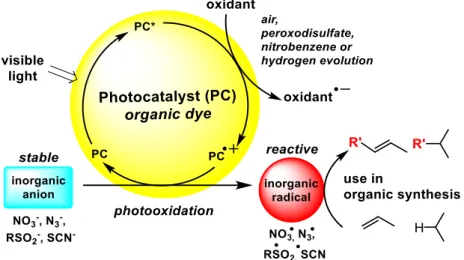
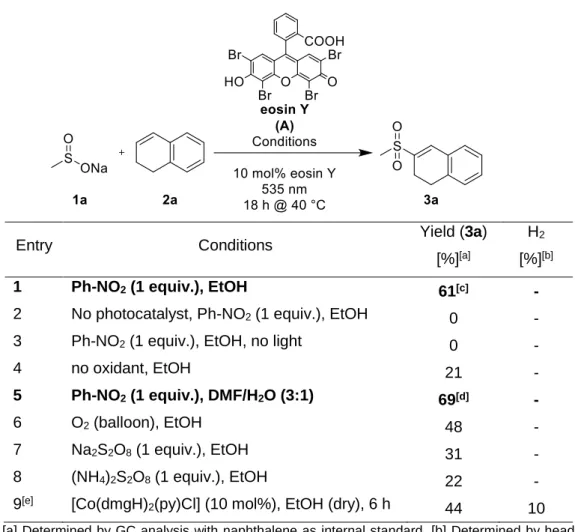
![Table 2-2. Synthesis of cyclic sulfones 4 and 5. [23]](https://thumb-eu.123doks.com/thumbv2/1library_info/3941209.1533326/38.892.168.768.241.793/table-synthesis-cyclic-sulfones.webp)
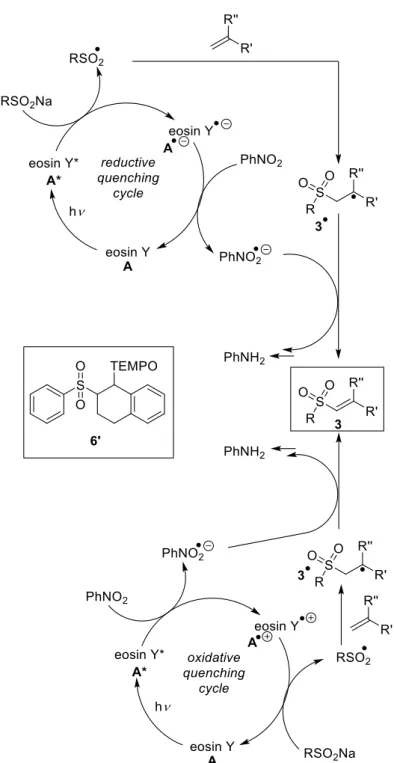
![Table 2-3. Transient species of eosin Y and its lifetimes under various conditions; [a] wavelength of detection; [b] not observed; [c] radical anion of eosin Y was not observed; [d] average value from at least 5 measurements](https://thumb-eu.123doks.com/thumbv2/1library_info/3941209.1533326/41.892.145.775.755.912/transient-lifetimes-conditions-wavelength-detection-observed-observed-measurements.webp)
